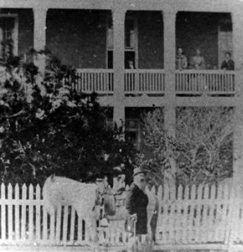
Spanish mustangs weren’t the only source of Oriental blood in the early Quarter Horse. In fact, several Arabian stallions from one of the first groups of desert-bred American imports made their mark in Texas prior to the Civil War.
Dr. George Feris, Richmond, Texas, developed an admiration for Oriental horses during the Mexican-American War (1846-1848), when he rode a horse whose first dam was sired by Amurath, a Barb stallion imported to New York from Tripoli in 1838. The second dam of Feris’ mount was sired by Stamboul, an Arabian given to Charles Rhind, U.S. minister to Turkey, by the Sultan of Constantinople.
“For style, courage and endurance, he took the palm from all others, but was unfortunately killed by a lance thrust at the Battle of Buena Vista,” Feris wrote to Randolph Huntington in 1887.
It was esteem for his war mount that led Feris to seek Arabian horses for breeding stock and to Kentucky horseman A. Keene Richards, who in 1855 was planning an expedition to the Mideast to purchase the best Arabian stock he could find.
In 1856, Richards returned to America with eight pure Bedouin-bred Arabians, two of which, Hamdan, a two-year-old gray colt, and Sadah, a gray mare, were selected by Feris for his farm in Texas.
Hamdan died in 1861, after just two years at stud. But Sadah produced several foals for Feris, including his favorite stallion Abdel Kader who, because of his outstanding offspring, became well known in Texas and south of the Rio Grande as the “Feris Arabian.”
One of Abdel Kader’s colts, a gray two-year-old named Sheik, sold for $3,000, an enormous amount for the time, when an average adult horse cost between $60 and $80. In addition, Feris sold another two-year-old gray colt, Druse, for $1,600, and two other colts for $3,600, as a pair.
Researching the heritage of ranch horses from famous Texas ranches of the mid to late 1800s, I sometimes find reference to offspring of “Arab” stallions (see my recent article on SMS Ranches) and have wondered where they came from, at a time when purebred Arabians were rare in America.
Abdel Kader and Hamdan, who is registered in Volume I of the Jockey Club’s American Stud Book (at a time when the Thoroughbred breed was still evolving), as is Abdel Kader’s dam, Sadah, I suspect live on through some of our modern day cow horses.
